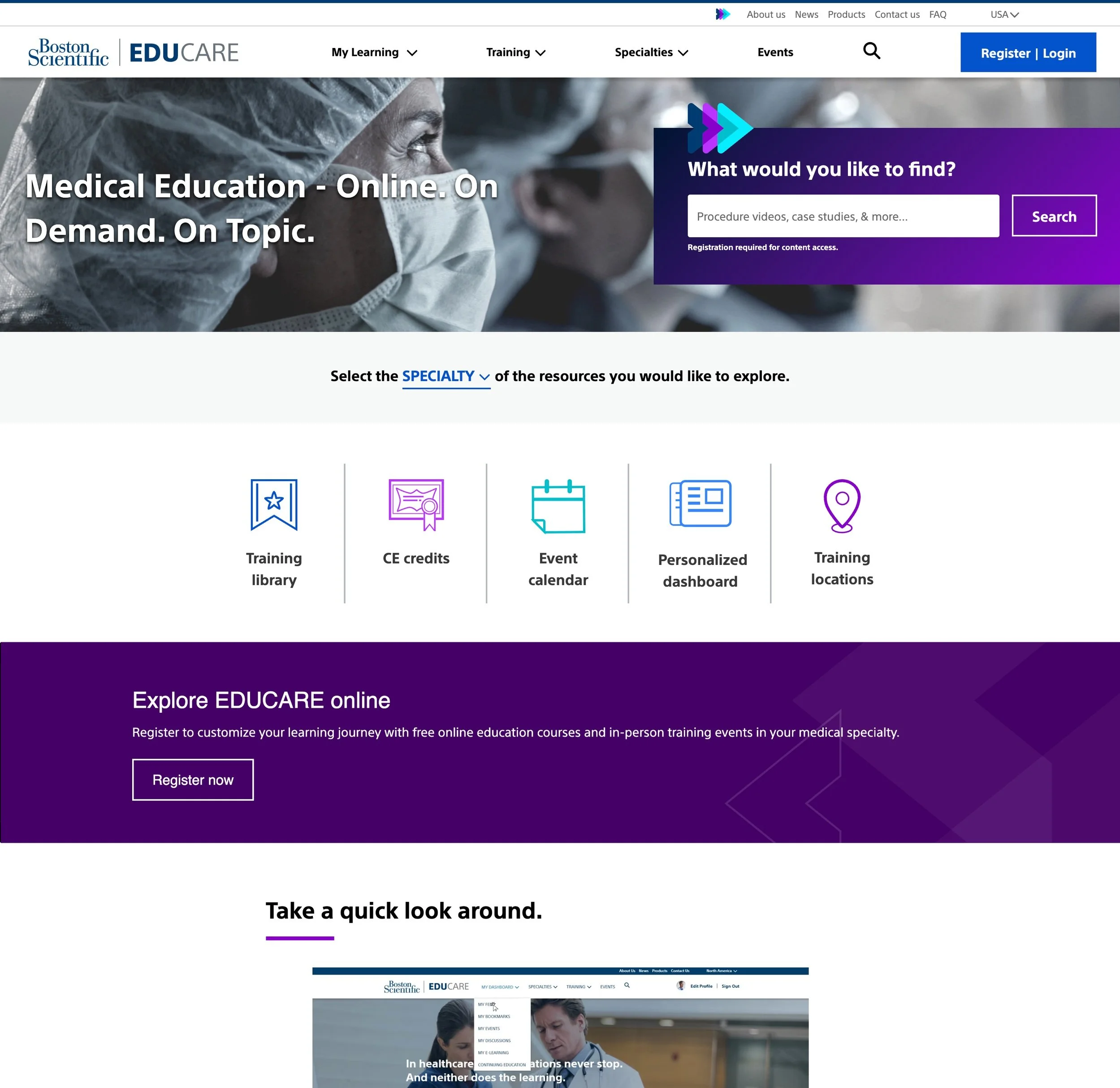Redesigning the Global EDUCARE Platform
Preview of the redesigned EDUCARE homepage
Overview
The global EDUCARE platform is a cornerstone of Boston Scientific’s efforts to deliver high-quality educational resources to healthcare professionals (HCPs) worldwide. This case study highlights how a research-driven redesign addressed user pain points, improved usability, and aligned with the company’s rebranding strategy.
My Role: Senior Product Designer
Team: Cross-functional collaboration between COE, SMEs, and BSC stakeholders and recruiting agency for research
Timeline: February 2021 – Left Boston Scientific in June 2022
EDUCARE homepage in 2021: United States
EDUCARE homepage in 2021: European Region
The Challenge
The EDUCARE platform faced multiple challenges:
Fragmented User Experience: Each region had its own EDUCARE implementation, leading to inconsistent designs and user workflows.
Legacy Platform Dynamics: The European EDUCARE site, as the original platform, heavily influenced user expectations, but the newer US EDUCARE site was designated as the design "north star."
Simultaneous Developments: The Latin American and Asia-Pacific EDUCARE platforms were being built concurrently, requiring real-time coordination.
Global Coordination Complexity: Working with diverse regional teams to align on a unified vision was essential. Each region had distinct needs, but the designs had to remain cohesive to support a scalable, globally consistent platform. This required balancing:
Regional customization for localized needs.
Adherence to global design principles set by the "north star" US EDUCARE platform.
Timely collaboration with teams in different time zones and cultural contexts.
These challenges underscored the need for a research-driven and iterative approach to ensure that the final design addressed the needs of healthcare professionals worldwide while maintaining Boston Scientific’s brand identity.
The Discovery
The redesign process began with a thorough investigation into user needs and platform shortcomings. This involved both external and internal sources:
External Sources
2020 HCP Interview Sessions: Uncovered key pain points in existing workflows and unmet needs for on-demand education. [Research done prior to my taking the EDUCARE design role]
July 2020 UX/UI Audit: Evaluated the platform’s usability and adherence to design best practices, identifying areas for improvement in navigation, layout, and content hierarchy. [Research done prior to my taking the EDUCARE design role]
2021 HCP Interview Sessions: Collected insights from diverse specialties (Rhythm Management, Surgical Endoscopy, Interventional Cardiology, etc.), revealing distinct preferences and commonalities in platform usage.
2022 HCP Interview Sessions: Talked to Rythm Management clinical staff and electrophysiologists to validate initial findings and explore advanced feature requirements within certain specialties.
Internal Sources
BSC Conversations and Feedback: Synthesized input from internal stakeholders to align platform improvements with business goals.
BU Jira Requests: Analyzed feature requests and bug reports for actionable trends.
COE and Spokes SME Collaboration: Partnered with regional SMEs to understand localized needs and ensure global consistency.
Discussions with CMO and HCP Employees: Gained executive buy-in and further refined the vision for the platform.
Mapping the voice of customer feedback to the EDUCARE pages and features.
Key Findings:
Users needed a more intuitive navigation system to find educational materials quickly.
Region-specific content and workflows demanded customization while maintaining a global framework.
A consistent and modern visual identity was crucial for reinforcing the Boston Scientific brand.
Design and Iteration Phase
Design Principles
The design strategy was guided by four principles:
User-Centricity: Address pain points identified during research.
Consistency: Create a unified design system across regions.
Scalability: Ensure the platform could grow with future needs.
Brand Alignment: Reflect Boston Scientific’s rebranding initiative.
Prototyping and Testing
Created wireframes and clickable prototypes to validate navigation, layout, and feature concepts.
Conducted iterative usability testing with HCPs and internal stakeholders.
Incorporated feedback from diverse global regions to refine the designs.
Design Highlights:
Simplified navigation with a universal search feature.
Responsive design optimized for desktop and mobile devices.
Customizable regional content templates for global consistency.
Outcomes and Reflections
Anticipated Impact
While I departed Boston Scientific before the full rollout of the redesigned EDUCARE platform, my work laid a strong foundation for its successful implementation. Based on usability tests, stakeholder feedback, and the validated design solutions, I anticipate the following outcomes:
Improved navigation and usability across global regions.
A cohesive user experience aligned with Boston Scientific's branding.
Increased engagement with educational resources by HCPs.
Next Steps for EDUCARE
While no longer directly involved, I am excited to see how Boston Scientific continues to evolve the platform, leveraging the groundwork established during the redesign. Potential future enhancements include personalized content recommendations and AI-driven user insights to further elevate the HCP experience.














